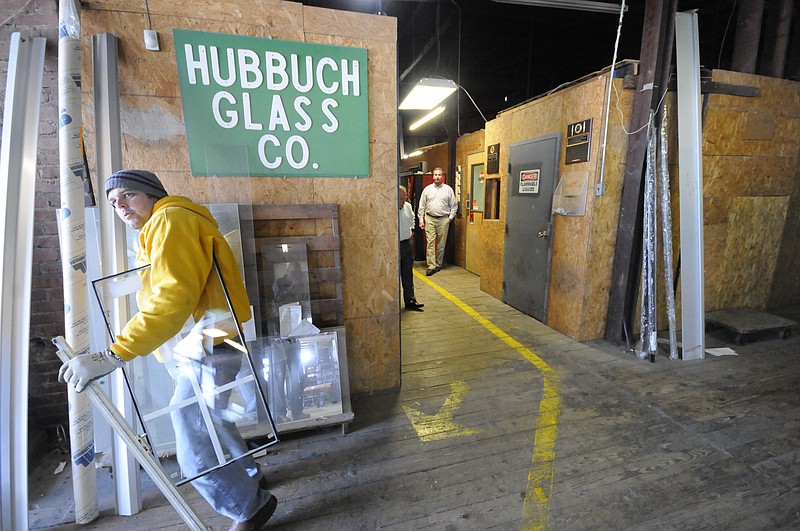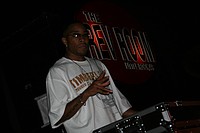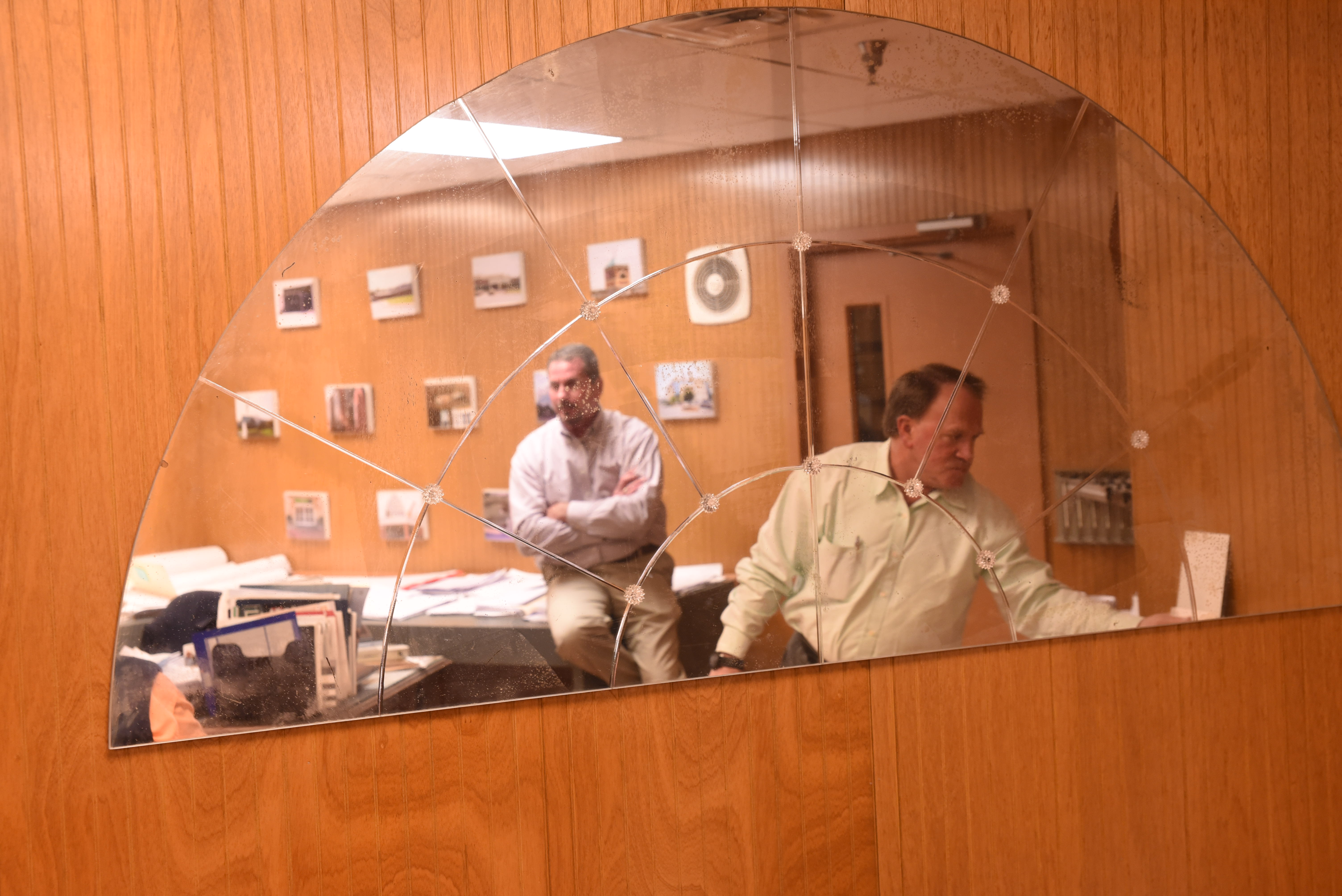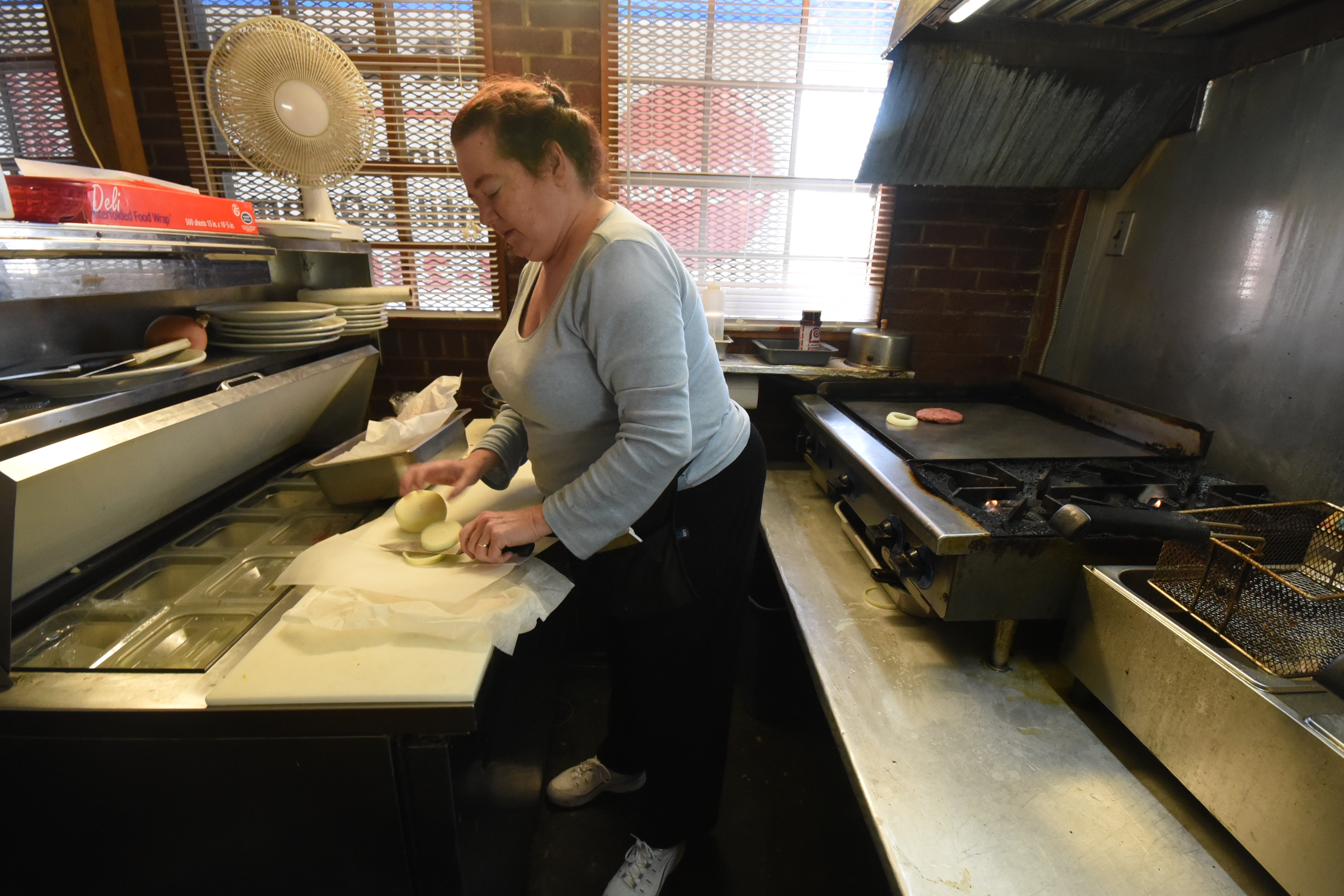Hanging on the wood-paneled wall in Don Johnson's office is a large, arched mirror that once adorned one of eight alcoves in the lobby of the Read House.
At almost seven feet across, it's a pretty-enough piece, a grooved sun-ray pattern cut into the glass and floral medallions set in holes where the lines intersect.
Still going
Here are some other regional businesses that have been around for decades; some have remodeled, but they're all in the same spot where they originally opened. Mount Vernon Restaurant, Broad Street Gordon's Cleaners, McCallie Avenue Nikki's Drive Inn, Cherokee Boulevard Walter A. Wood Supply Co., Rossville Boulevard Brody's Jewelers, Rossville Boulevard Pioneer Barber Shop, Ringgold Road, East Ridge Kingwood Pharmacy, Ringgold Road, East Ridge Dixie Freeze, Elm Avenue, South Pittsburg, Tenn. Oakwood Cafe, West Cuyler Street, Dalton, Ga. Sear's Shoe Store, LaFayette Road, Fort Oglethorpe, Ga.
Created in 1926 by Hubbuch Glass, which Johnson now co-owns and serves as president, the mirror was brought back to Hubbuch and Johnson's office in 2006 when the company was asked to help in the Read House remodel. It's a nice piece of work, and the fact that it hung in one of the city's most historic hotels is nice, but it represents much more to Johnson, now president of Hubbuch on Central Avenue.
"When it was made, it was a state-of-the-art piece," Johnson says. "Pretty much everything they did then was state-of-the-art at that time."
The arch was built by employees of Otto Hubbuch, who started the company in 1917. He moved the business to its current location in 1927 and, not only has the site not changed over the years, little else has changed, from the staff, the way they do business or the building -- a single-story, rectangular-shaped brick edifice originally built for Hubbuch by the railroad, which agreed to follow Hubbuch's design in exchange for rent.
The loading dock sits right next to the tracks, which allowed workers to load raw materials in and finished products out with relative ease.
The same is essentially true at Zarzour's restaurant on Rossville Avenue off Main Street and at Bea's restaurant on Dodds Avenue. They, too, are businesses that look and operate much the way they have since opening decades ago. Except for fixing things when they break, repainting when necessary or introducing computers in the office for tracking clients or inventory, regular visitors would notice little change at either.
In a city like Chattanooga, where changing the face of the city has been a basic philosophy for almost 30 years, these businesses are proud holdouts, maintaining their looks, traditions, even day-to-day operations while waves of change flow all around them.
Zarzour's
At Zarzour's, a small, brick building with a half dozen small rooms, husband and wife Charles and Nezira Zarzour originally converted the front of the family's house into a small bar that sold beer, chili and stew in 1918; the family has been operating there ever since. In fact, it has been open five days a week for lunch nearly every day since opening day.
For years prior to the revitalization of once-thriving Main Street and the Southside -- which had deteriorated into boarded up buildings and shuttered businesses, Zarzour's gave life to a then-dying part of town, drawing regular customers looking for a vegetable plate or a burger.
Great-granddaughter Shirley Fuller is the current owner and her daughter-in-law, Shannon Fuller, who is married to Shirley's son, Joe "Dixie" Fuller, runs it.
"Joe is fourth generation," Fuller says of her husband.
Shannon is there each day and knows most customers by name, as well as how they like their cheeseburgers. She and two other employees cook, wash dishes and wait on the customers, and Fuller is also the de facto cash register and adding machine. The decades-old brass cash register on the bar works only as a till today, and Zarzour's doesn't take credit cards.
"I am the computer," she says. "I can look around at any given time and, within 10 seconds, know what everybody owes me."
That's partly because Fuller is good with numbers, but it's also because the menu, which is essentially a photocopied piece of paper with the regular offerings typed on it and the daily specials handwritten on it, is spartan. Because she does it every day, Fuller can look at the food on plates at individual tables and instantly tally up the bill for a vegetable plate with sweet tea and a piece of chocolate icebox pie.
The floor and walls of Zarzour's are original and the configuration of the main room, including where the grill and bar sit, haven't changed in 97 years. Water damaged the roof and ceiling a few years back, so a new acoustic drop ceiling covers the original tin tiles.
In the '60s and '70s, George Zarzour spent hours on his ham radio set in his office in the back; on the door to the office is a plaque carrying his radio call letters "W4NUW." The home's living room, which at one time served as a bedroom, was converted into more dining space in the late '70s after Shirley took over running the place from her Uncle George and Aunt Rose, who were brother and sister.
The range hood was installed in the '50s. The gas cooktop was replaced not long after Fuller began working there. Other than the ceiling, the newest additions to the place are the air conditioners, which were added in the last several years. Cutting through the concrete block to make holes for them was no easy task, Fuller laughs.
Seated at a table in the middle of the main dining area, rolling napkins for the next day's lunch, Fuller says, "This is my favorite place and thing to do. This is where I think and unwind." As she works, she relishes pointing out the various family members in photos that hang around the restaurant.
"I love this place," she says. "I know more about Joe's family than my own."
Bea's Restaurant
If you walk into Bea's Restaurant, with its fading yellow aluminum-siding exterior, you see the same open floor plan that Bill and Beatrice Steele used when it opened in 1950. Inside, where you'll find low ceilings, wood paneling and fragmented tile flooring, patrons sit at round tables with Lazy Susans piled high with bowls of fried okra, turnip greens, slaw, barbecue, peach cobbler and fried chicken.
The Steeles originally introduced the Lazy Susans and buffet-style food delivery shortly after opening as a way to quickly serve the clientele who needed to eat and get back to work.
Unless you go in with seven friends and get an open table, you are likely to be seated next to people you've never met. The Steele's grandson, Doug Bradshaw, runs the restaurant these days and says that when strangers sit down next to each other to eat, they invariably strike up a conversation and soon learn they have several mutual friends or connections.
It's part of the charm for the eatery. "Visually, it looks the same as it always has," Bradshaw says. "It works. There is no need to modify. People know when they leave home what they are going to get, and they like it."
Hubbuch Glass
Bob Cummins is one of the five owners of Hubbuch. He is also the new kid on the staff with a mere 15 years on the job. Johnson started as a 19-year-old college student in 1975.
Cummins, along with Johnson, Britt Canada, Peggy Keener and Theresa Cross, bought the business in 2005. It employs six front office people and 30 in the warehouse.
Until 1962, it primarily made wood-framed mirrors. That stopped when the Chattanooga pollution board forced Hubbuch to stop because chemicals from the silvering process were rising into the atmosphere and also other companies, particularly those in North Carolina, were producing cheaper versions.
Hubbuch, then under the direction of son Bill Hubbuch, moved from mirrors into making storefront and bathroom glass. In the late '60s, Hubbuch wanted to do a "$1 million dollar job," Johnson says, so he lowered his bid on what would become the "Gold Building" on Pine Street. It took three years to complete and finally opened in 1970, serving as offices BlueCrossBlueShield of Tennessee until the building was sold in 2010 and BlueCross moved to its new location on Cameron Hill.
Today, Hubbuch makes most of its money in aluminum windows. It actually cuts the frames and makes the windows on site. Though the materials have changed, the business and, in particular, the warehouse, operate much the same as always. Glass cutters and frame cutters work on the same large wooden tables that were brought in when the business opened. Those tables sit on the original wood flooring.
The 15-inch DeWalt radial-arm saw used to cut the frames was put in place in the '50s. In 2002, part of the space once used for frame- and mirror-making was remodeled to create more office space. But visitors to the warehouse see the original exposed timber framing of the roof and walls and the wood floors. The storage bins where the glass is kept are also original. You can even follow the original yellow line painted on the floor that takes you to the pick-up area.
The only real change is that glass is no longer delivered by rail to the loading dock; instead, it comes through the front of the building. Johnson says vinyl siding also was added to the exterior.
"We didn't do the windows, though. It was too expensive," he says with a big laugh.
Though Hubbuch uses a computer for keeping up with accounts and emails, customers' information is still kept in a 5x7 receipt book. Since such books are hard to find these days, Cummins says they simply scratch out the year and write in the current one on the reusable binders.
"About as high tech as we get is a copier machine," he says.
Keener, who greets customers along with Cross, answers the phone and handles the company's books. "We've had to adjust the way we do business," Keener says, "but the building operates the same way."
Johnson says, "The biggest adjustment was email. When I started, we didn't have faxes. People either mailed us their orders or drove them here."
None of the owners at Hubbuch, Zarzour's or Bea's foresee making any changes at their businesses, nor can they imagine moving.
"This is home," Johnson says.
Cummins adds that, while there are plenty of things the warehouse part of Hubbuch could use -- heat and air conditioning chief among them -- "the guys don't complain unless it is really, really cold or really hot. Like he said, this is home."
Contact Barry Courter at bcourter@timesfreepress.com or 423-757-6354.



